Investments in environmental protection
Data extracted in October 2023.
Planned article update: September 2024.
Highlights
Between 2006-2022, 44 % of environmental protection investments were devoted to wastewater; the second largest category was waste management with 23 %, followed by air protection with 11 %.
Between 2006-2022, environmental protection investments in the European Union (EU) increased from €53 billion to €69 billion, corresponding to an annual growth of 1.6 % over the period.
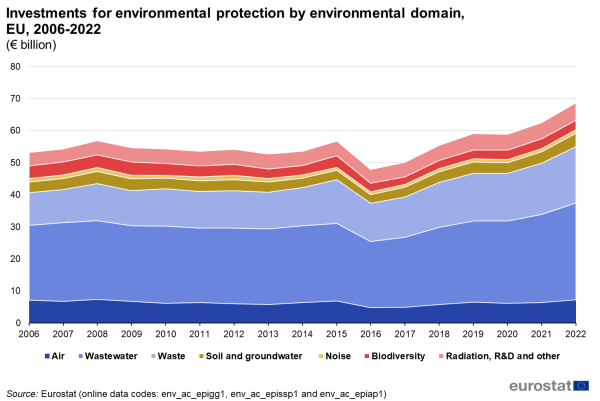
(€ billion)
Source: Eurostat (env_ac_epigg1), (env_ac_epissp1), (env_ac_epiap1)
This article is focused on 2006-2022 environmental protection investments in the European Union (EU) as defined in the Environmental Protection Expenditure Accounts (EPEA).
EPEA provides information on investments done by resident units to maintain and expand society’s capacity to protect natural assets (e.g. air, soil, water) as well as to prevent, contain and clean up pollution related to them (e.g. waste and waste management). Data are available by institutional sector (corporations, government and non-profit institutions serving households - NPISH), and are detailed by environmental domain according to the classification of environmental protection activities (CEPA 2000).
This article complements the article on environmental protection expenditure which provides an overview of the National expenditure on environmental protection (NEEP) aggregate.
Full article
Key indicators and breakdown by environmental domains
According to Eurostat estimates, between 2006-2022 environmental protection investments in the European Union (EU) increased from €53.1 billion to €68.7 billion, corresponding to an annual growth of 1.6 % over the period.

(€ billion)
Source: Eurostat (env_ac_epigg1), (env_ac_epissp1), (env_ac_epiap1)
Most of the environmental protection investments went to wastewater management. Investments in wastewater management include investments in new processes designed to reduce water pollutants or wastewater generated during production, investments in operation, maintenance and repair of sewerage networks and of sewage treatment plants, treatment of cooling water, treatment of sewage sludge for disposal or other uses (e.g. agriculture, incineration with energy recovery and biogas production). Wastewater management on environmental protection investments accounted, on average, for 43.7 % of total environmental investments in the whole period (see Figure 1). A relevant amount of investment was also devoted to waste management (22.8 % of total on average), with a share on total environmental investments that grew from 19.4 % to 25.7 % between 2006 and 2022 (see Figure 1).
Environmental protection investments and total investments of overall economy show a similar trend in the whole period, except in 2009 when total investments decreased significantly more than environmental protection investment and in 2016 when total investments increased by 3.9 % and environmental protection investments decreased by 15.4 % compared with 2015 (see Figure 2).
The environmental protection investments accounted, on average, for 2.3 % of total investments between 2006 and 2015 and for 1.9 % in the subsequent period (see Figure 2).
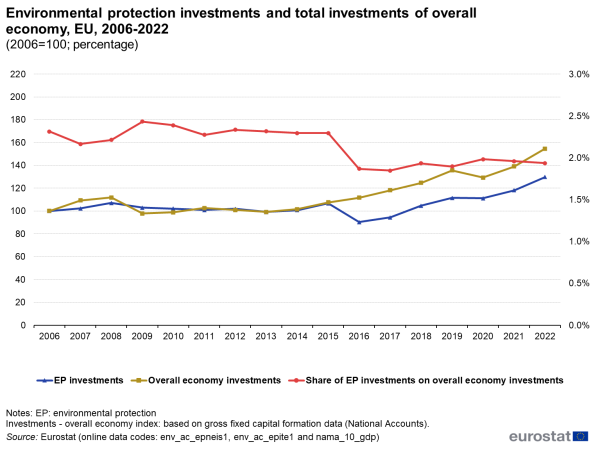
Source: Eurostat (env_ac_epneis1), (env_ac_epite1), (nama_10_gdp)
Environmental protection investments by institutional sector
Over the whole period, the corporation sector accounted for the highest share of environmental protection investments and increased from 53.7 % in 2006 to 64.6 % in 2022 (see Figure 3, left-hand scale); the share in total corporations’ investments remained relatively stable around 2 % (see Figure 3, right-hand scale).

(€ billion)
Source: Eurostat (env_ac_epigg1), (env_ac_epissp1), (env_ac_epiap1), (nasa_10_nf_tr)
The general government (GG) and non-profit institutions serving households (NPISH) accounted for the remaining share of environmental protection investments; the share in total general government investments decreased in the same period from 7.2 % to 4.8 % (see Figure 3, right-hand scale).
Figure 4 and Figure 5 show the investments of general government and corporations by environmental domain respectively.
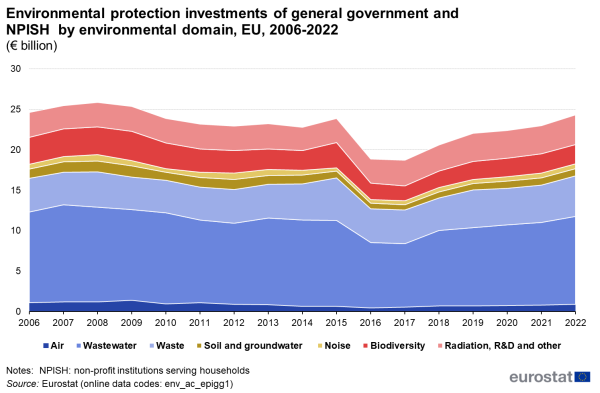
(€ billion)
Source: Eurostat (env_ac_epigg1)
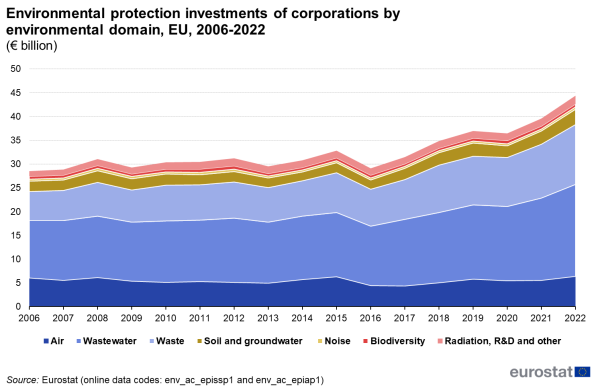
(€ billion)
Source: Eurostat (env_ac_epissp1), (env_ac_epiap1)
In both sectors the highest share of investments is for the management of waste and wastewater services. As for the other environmental domains, general government investments are mainly devoted to biodiversity protection and to radiation, R&D and other (which includes environmental administrative and regulation activities, education, information and training activities) while corporation investments go to air protection.
Corporation investments by type of producer and activity
The corporation sector includes both the corporations providing environmental protection services on the market (i.e. specialist and secondary producers of environmental services; e.g. private companies dealing with waste collection and processing and with sewerage) and other corporations carrying out environmental protection activities (reduction of emissions, treatment of pollutants) made necessary in order to limit the environmental pressures arising from their production process (e.g. equipment reducing their air emissions). Figure 6 focuses on corporation investments broken down between specialist (i.e. units that perform environmental activities as their principal activity) and secondary producers (i.e. units that perform environmental activities but not as their principal activity), and other producers. The latter are also broken down by NACE activity. From 2006 to 2022, the share of investments by specialist and secondary producers increased from 46.7 % to 56.7 % of total corporation investments (see Figure 6).

(€ billion)
Source: Eurostat (env_ac_epissp1), (env_ac_epiap1)
With specific regard to corporations other than specialist and secondary producers (see Figure 7), a more detailed analysis of investments by environmental domains shows differences depending on the kind of environmental pressures mainly exerted. In 2022, water supply corporations invested mainly in wastewater management. Electricity, gas, and steam supply corporations as well as mining and quarrying and manufacturing companies invested mainly into protection of air. All other corporations (i.e. corporations included under other business sector) invested mainly to treat wastewater and waste generation as well as pressures exerted on soil and groundwater.
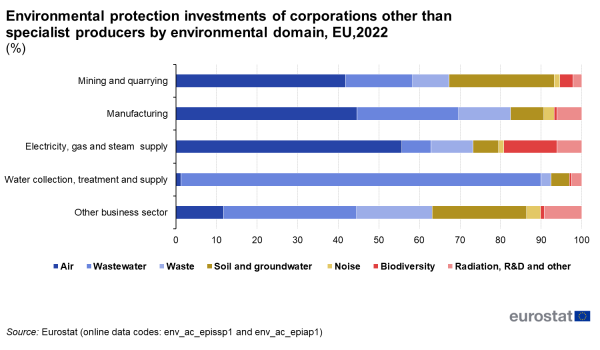
Source: Eurostat (env_ac_epissp1), (env_ac_epiap1)
Source data for tables and graphs
Data sources
EPEA are a module of the European environmental economic accounts set out under Regulation (EU) No 691/2011 on European environmental economic accounts, as amended by Commission Delegated Regulation 0125/2022. EPEA follows the international standards of the System of Environmental-Economic Accounting 2012 Central Framework (SEEA CF 2012), and are broadly compatible with the international System of National Accounts (SNA 2008) and its European version, the European System of National and Regional Accounts (ESA 2010). According to Commission delegated regulation 2022/125, the first reference year is 2020. In each data transmission to the Commission, Member States shall provide annual data for the years n – 2, n – 1 and n, where n is the reference year. Data for the EU Member States have a legal obligation to report EPEA data. EFTA countries, candidate countries and potential candidates are also collected and disseminated on Eurostat database.
Statistics on EPEA provide data on a wide range of important economic variables, such as gross fixed capital formation (investments), output, final and intermediate consumption, exports and imports, taxes less subsidies, compensation of employees, consumption of fixed capital, employment, current and capital transfers and earmarked taxes (for financing environmental protection measures). The data are broken down by environmental domain and institutional sector.
Missing statistical information on mandatory data reporting is estimated by Eurostat through an ad hoc gap-filling procedure, based on different methods according to data availability. Data annually submitted by countries and validated by Eurostat are used in the gap-filling procedure. The main data sources for imputation of missing data are data on General Government expenditure by function (COFOG - UNSD classification of functions of government, replicated in ESA201) and by type of transaction and national accounts data. EU aggregates estimates are produced by summing up the transmitted or imputed country data.
Imputed country data are not disseminated but only included in the calculation of EU aggregates. Only country data provided in the EPEA questionnaire are disseminated, once the validation procedure has been completed.
Due to the imputed country data included in the calculation of EU aggregates, the sum of data published for Member States may not match with EU estimates.
In particular, data on environmental protection investments are available on the Eurostat database (env_ac_epite1), (env_ac_epigg1), (env_ac_epissp1) and (env_ac_epiap1).
Direct access to
- Environment (t_env), see:
- Environmental protection expenditure (t_env_epe)
Dedicated section
Methodology
- Methodological publications
- ESMS metadata files
- Environmental protection expenditure accounts (ESMS metadata file — env_ac_epea_esms)
Regulation (EU) No 691/2011 on European environmental economic accounts amended by Commission Delegated Regulation 0125/2022.